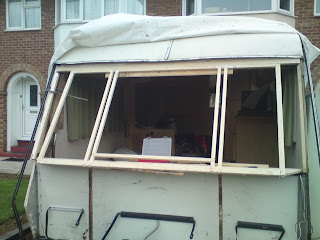So having lived with the poor idle and throttle response on my 1999 TXT 250 I have eventually "got the hump"
Of course I considered the obvious - sell it on Ebay and buy something else, but its just not my style. Why do that when I could take it to bits in search of the cause.
I had looked at the exhaust and carb early on and other than internal baffle damage I found nothing obvious. A new plug and and an increase in the size of the pilot jet had eased the symptoms. But now, some 4 trials later, I feel the problem is holding me back. Its not that I am blaming the tools but rather I am pretty crap at this trials thing, thus I need all the help I can get, and a bike that runs well can only help, right?
Anyway enough mumblings lets get on with the show...
The Symptoms:
Most obviously the Idle is unstable and the bike responds poorly to a large dose of throttle from idle. Initially it bogs then revs and settles slowly. If left it unprovoked it will slowly progress towards inevitable stall, regular blips are needed to keep it going. None of which helps when navigating a section! The idle mixture screw is effective from fully in to about 2 turns out then makes no difference. (The clue... something else is controlling the idle conditions)
The Plan:
I think its lean at idle, the hesitancy and lagging response point that way. Also applying a bit of choke even when hot helps the response for a short period. The inlet track looks OK and no signs of base gasket leaks. The filter is intact, correctly positioned and clean. So possibly a leaking bottom end seal (flywheel). Another train of thought is simply strip and rebuild from the start, then I'll know whats in there and how good the motor really is.
Having ordered 2 crank seals, crankcase gasket, head gasket and a new set of read petals we are good to go. A shout out to Gas Gas UK (
Tel: +44 (0)1298 766813) for the great service so far, delivery is fast and staff are knowledgeable, well done and thanks.
Pulling it apart:
I wont bore you with the chassis removal - assume it fell out and now its on the bench!
 |
| HERE WE GO...... |
 |
| CARBONISED HEAD |
 |
| READ GAPS!! |
 |
STATOR PLATE POSITION
|
 |
| HOMEBREW CRANK NUT REACTION SPANNER |
This nut was tight and the lock washer was only going to make things harder, So I started the compressor and attempted a gentle run with my 1/2" Aldi Air impact Gun, but yet again this piece of crap tool had seized up over the winter, so after 10 frustrating minutes trying to free it up I chose to beat it to death with a hammer and threw it in the bin!
Attempt 2 - 10 mins making the spanner above and the nut had no choice but to surrender. Job done and another special tool for the box!
 |
| KICKSTART SPRING |
 |
| GEAR SELECTOR ASSY |
At this point photos are limited but from the stages above I proceeded to remove all clutch related parts and split the cases. The cases were stubborn to move and I found that tapping with a mallet was going no where. Instead I used 2 bolts in the underside casing and prised the half's open with some soft wood. A very gentle approach with repeated applications of force saw the half's ease open.Once apart I gained a better understanding of what was going on. The internals looked like a coal mine, I suspect the blocked baffle that I sorted in the first few days of owning the bike had been blocked for some time. Hence exhaust gas had been forced into the crankcase and coated everything. New main bearings were certainly needed (ordered from RS components for £5 each, spec number: 6062 ) I used an electric heat gun to warm the casings and pressed the bearings out, heat may not be necessary but certainly helps to ease the job.
Everything was then given a thorough clean and inspection. The piston and bore looked to be in good health, measurements with the bore gauge showed skirt clearance to be at just under 0.003". I deemed this OK to go back together - considering also that Gas Gas UK could only offer a piston kit at £125 then my budget means the rings would be also continuing service, for the time being at least.
The bearings were pressed into the casings (again with pre- warmed casings) in readiness for the rebuild.
To be continued.....












































